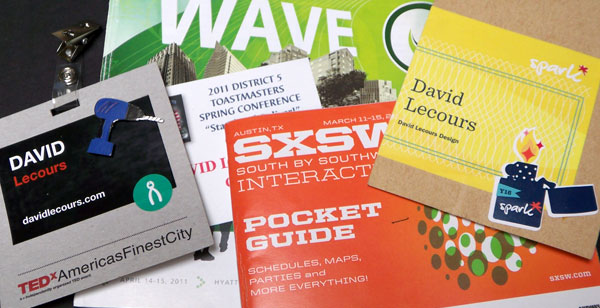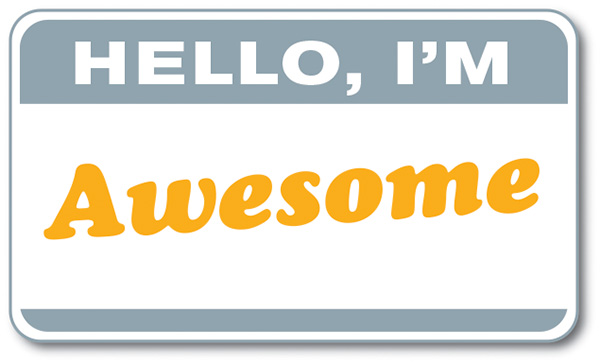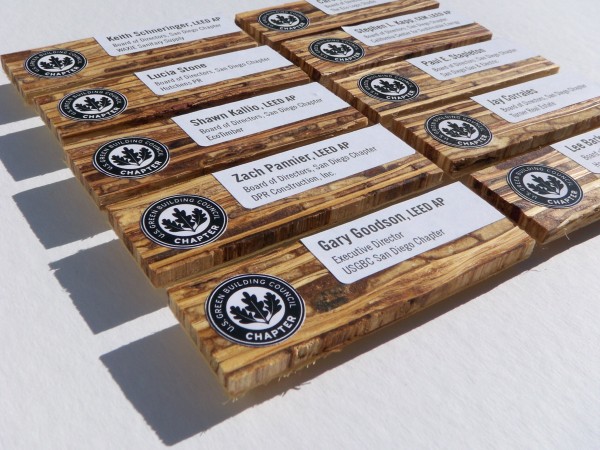
by davidlecours | Jun 1, 2011 | Experience Marketing

Do you enjoy attending conferences as much as I do? Meeting new people, exposure to new ideas and idealism are all infectious. But a week after the conference is over, what really sticks with you? Is your investment of time and money worthwhile? Here are 8 Tips for marketers to get the most out of attending your next conference.
1. Choose The Right Conference
It’s tempting to only attend conferences where your tribe gathers (fellow marketers, architects, engineers, etc.). This can be good for teaming, but also choose conferences where potential clients gather. Ask your current clients, in your targeted industry, which conferences they attend. Then consider who the speakers and attendees will be. I’ve found that regional conferences like SMPS The Wave offers more intimacy and a higher concentration of potential clients than national conferences.
2. Don’t Just Attend
A great way to build brand awareness for yourself and your firm is to be visible at a conference. The best way to do this is get on the agenda as a presenter. Start with being a panelist in a breakout, then a sole presenter. Move your way up the food chain to be a panelist or keynote speaker in a main session. Conferences typically put out a request for presenters at least 6 months prior to the event. Another great way to build visibility at a conference is to be a sponsor (but only if this allows for personal introductions to VIP organizers or attendees). Consider volunteering to help organize the conference in a way that allows you to demonstrate your talents, or develop a new skill. In short, connect yourself to the conference to benefit from the halo effect.
3. Pre-Conference Networking
Conferences always announce speakers before the event as a marketing tool. Determine which speakers you would like to meet and start following them on Twitter or subscribe to their newsletter. Help to promote their session at the conference by tweeting something like “I’m excited to learn from @lecoursdesign at the @SMPStheWave conference.” Genuine flattery will make you more memorable when you actually meet the speaker at the conference. The previous tweet also helps to promote the conference itself which might gain you an extra drink ticket from your new friend, the conference organizer. Conferences will often pre-announce attendees. This is a great opportunity to reach out to those you’d like to meet. Pre-arrange meeting for a meal, or for coffee during a break, because nobody likes being that lonely guy standing around trying to look occupied.
4. Planning, Goals, and Flexibility
Once the conference starts, it’s easy to simply follow the herd. But you need to be selfish to make sure your needs are met. Get clear on why you are attending a conference before you register. This can be your purpose. Then set some goals that will support that purpose. For example, you may want to meet 5 new client prospects, gain 3 new blog ideas, or find 2 potential teaming partners. Look through the conference agenda to make a tentative schedule for the sessions and breakouts you prefer to attend. Then be flexible enough to adapt when Seth Godin asks you to lunch because you pre-conference tweeted about his session.
5. Capture Content Digitally
I am migrating from taking handwritten notes in a notebook to using a laptop, and eventually a tablet. My handwriting can be illegible and I often use my notes as content for this blog so going digital is more efficient. By capturing your notes digitally, you eliminate the intermediary step of having to transcribe your notes. This increases the shelf life of that content. For visuals, use your smart phone or digital camera to capture key slides of a presentation. Digital video or audio capture is another great way to make sure you don’t miss a word.
6. Share What You Learned
It’s been said that you don’t really know a subject until you teach it to someone else. A great way to digest the knowledge you consumed at the conference is to share it with others. Those that weren’t able to attend the conference will appreciate this. Those that did attend will appreciate a review, and also hearing about alternate breakout sessions that they were not able to attend. One way to share is to live tweet those nuggets of wisdom your followers would appreciate. Or, share a blog post about individual sessions or highlights of the entire conference.
7. Meeting New People
A big motivation for me to attend conferences is to meet new people. But as an introvert, this can be challenging. Introducing oneself is awkward for most people. An effective icebreaker is to ask “what did you think of the previous speaker/session?” or “what’s the best thing you’ve heard at this conference?” There is no doubt that you’ll be asked “what do you do?” or “where do you work?” Have a self introduction that is intriguing enough that people will ask follow-on questions. For more info on writing a good self introduction, click here. A final tip is to eat lunch with people you don’t know. One of my best friends today is someone that I met at lunch at a conference over five years ago.
8. Absorb As Much As Possible
Conferences can be physically, mentally and emotionally tiring. Sleep on the plane or when you get home. Seize every opportunity that the conference offers to get a full return on your investment. Some of the best conversations and connections get made around the periphery of a conference. I’m still kicking myself for not joining a group going out after SMPS The Wave. I missed out on a live mermaid swimming in a giant tank. It even inspired Josh Miles to write a great post How a Mermaid Got Me Talking About a Brand.
I hope these tips are useful for you to get the most out of a conference. What have I missed? What are some strategies you use when attending a conference?

by davidlecours | Jun 22, 2010 | Experience Marketing

The self-introduction is such a simple and effective way to build awareness for you and your firm. Often called the “elevator speech,” I prefer “self-intro” because delivering a speech in an elevator is absurd. Plus, the goal is to engage in a dialogue, not deliver a monologue. When asked “what do you do?,” seize this opportunity. A compelling self-intro is a catalyst for someone to ask you follow-up questions. Before you know it, you’ll be engaged in a stellar conversation. Conversation leads to connection: the ultimate goal.
I understand that it’s awkward talking about yourself because you fear sounding pompous. As a result, most of us self-introduce poorly. But done well, it’s an authentic, two-way, targeted marketing communication tool that can instantly create a favorable impression for you and your firm.
Self-Introduction Basics
I recommend having two versions of your self-intro. The short version should be about 10-15 words. Mine sounds like this: “I’m a consultant & speaker helping AEC firms fight commoditization to win new business.”
Here are the key elements (using my example above). Include your occupation (consultant & speaker), target audience (AEC firms) and specific benefits received from working with you (win new business). The key is to craft something you’d say to a friend. If it is too canned, you’ll sound like a cheesy pre-recorded salesbot and you’ll never use it.
For the long version of your self-intro, start off with a question that demonstrates that you understand a commonly held challenge facing your target audience. I would ask, “you know how AEC firms are often perceived as commodities? Well, as a consultant & speaker, I help firms fight commoditization to win new business.” According to Michael Port, author of Book Yourself Solid, you might elaborate on your services or add an example of a “wow” success story. This would start off with something like, “can I share a story about a firm similar to yours that we helped?” Then you share that story.
Common Mistakes
I recently led a workshop on this topic for my Toastmaster’s club. Here are some areas where people struggled. By only stating your occupation, “I’m a marketer,” you instantly commodify yourself. Another pitfall is saying what’s true, but not unique. For example, “I work in marketing for an architecture firm.” Remember, this is a positioning statement which is about differentiation. Finally, watch for language that looks impressive when written but sounds ridiculous when telling a friend. If you include business cliches like “synergize, best of breed, core competency, win-win or paradigm shift,” then punch yourself in the mouth and start over.
Next Steps
The exercise of writing your self-intro forces you to narrow your focus and prioritize. Start working on your 10-15 word short version to pique enough interest that you’ll be asked follow-up questions. When your self-introduction is clear and concise, like the premise of a great movie, then others can easily spread your message like a blockbuster referral.
by davidlecours | Jan 13, 2009 | Experience Marketing

People do business with people they know. So, how do you get to know the right people that can hire or team with your firm? As an introvert who would rather spend time designing or writing, networking doesn’t come easy for me. I’ve had to push myself beyond my comfort zone. By following the four networking tips below, I have built an effective network and you can too.
1. Get Involved Where Your Clients Gather
Focus your time where your target clients gather. Since LecoursDesign’s niche is the A/E/C industry, I’ve found SMPS, AIA, and USGBC to be fertile ground for connecting with potential clients. But it’s not enough to simply join an organization or show up for meetings. In fact, meaningless small talk often pervades big monthly meetings. The place where meaningful relationships are built is working side-by-side on a committee or serving on the Board of Directors. Embed yourself where clients can get to know you on a personal level.
2. Volunteer Where You Are Passionate
Give your time to causes that you are passionate about. Even better if you can donate some expertise where they can be noticed by a potential client. Let me give you an example. I’m passionate about sustainability so serving as Marketing Chair of the USGBC-SD Chapter allows me to demonstrate my expertise to potential clients. For example, I designed the USGBC name tags above. Volunteering also allows you to practice new skills that a paying client might find too risky (you rarely get fired volunteering). When I started with USGBC, I knew very little about email marketing. The lessons I learned in managing e-mail blasts for USGBC directly informed the free monthly advice I send out monthly via email.
3. Obey the Law (of Reciprocity)
Give and you will get. The universe supports Newton’s third law: For every action, there is an equal and opposite reaction. According to Michael Port in Book Yourself Solid, share what you know, whom you know, and how you feel. You’ll be amazed with what comes back to you.
With networking, it’s more important to be interested, than interesting. It’s a myth that the most charismatic person in the room is the most effective networker. That guy (you know the type), the most interesting man in the world from the Dos Equis commercials, is usually perceived as a slick, self-interested, charlatan. When meeting someone for the first time, or fifth time, be interested in them. Ask about what they are working on, what problems they are facing, fun things they are doing outside of work, or about their family. Take it upon yourself to move quickly out of small talk land, and into genuine conversation. Show up to your event with good questions in your back pocket, and you’ll leave with meaningful contacts’ business cards in your front pocket.
4. Position Yourself as an Expert
I’ve found the best way get in front of my target audience as an expert is through public speaking. When I speak on Branding or Presentations at conferences or workshops, it always amazes me how many people come up afterward to give me their business card. This type of “pull” strategy of content marketing is so much more effective than “push strategy” of cold calling or advertising. If public speaking isn’t your thing, make it your thing by joining a local Toastmasters chapter because public speaking is a learned skill. But if you aren’t ready to speak publicly, start with writing. The trade organizations and publications your target reads are always hungry for fresh content. For example, I write for the SMPS-SD Newsletter that then gets repurposed into their blog. Find out who the editor of publication is that you’d like to submit to. Then, send a letter or call to introduce yourself. Ask how they would like to receive submission ideas, and if they ever need expert sources for articles written by others. Don’t sell your story ideas in your first contact. After you build a relationship, then propose an article where you can share useful knowledge (see tip #3 above) while demonstrating your expertise. If it gets published, be sure to send copies to your target audience.
by davidlecours | Sep 8, 2008 | Experience Marketing, Presentations
Recently, I had a really great marketing day. I’d like to share with you a few habits that led to my success. I didn’t invent these, and, you may have heard them before. The following tactics have been effective for me in marketing my firm, LecoursDesign, and should also work for you.
1. Present Proposals in Person
The morning of my really great marketing day started with a meeting I requested to present a proposal to re-design the KTU+A website. I could have faxed or e-mailed the proposal and checked it off my to-do list. But, I’ve found a much higher success rate by presenting proposals in person. It shows a deeper commitment to the project, allows the client to get to know you better, and allows for the opportunity to answer questions about process or pricing in real-time.
2. Volunteer and Network Where Your Clients Are
Later the same morning, I ran into the Marketing Director and VP of KTU+A at a networking event where they handed me the signed proposal that I had just presented. Hooray! I previously served on the Board of Directors of Society for Marketing Professional Services (SMPS) with the Marketing Director from KTU+A. She and I were also in the same Toastmasters group where she’d heard my speeches about the capabilities of LecoursDesign. So, when the RFP for their website came out, we were already well positioned in the mind of our new client.
3. Get In Front of Your Clients as an Expert
By noon of my great marketing day, I was on-stage at the recent USGBC / SMPS Luncheon. Being introduced to the audience as a Board Member and Marketing Co-Chair for the U.S. Green Building Council, San Diego Chapter elevated my awareness with 150 potential clients. One of which, the owner of Green Office Projects, introduced himself to me and inquired about the services of LecoursDesign. This was a lead that fits perfectly with our niche: building brands at the intersection of Architecture and CleanTech. Did it lead to a new project? You’ll have to wait until next issue to find out…
I’ve found recent success by dedicating 4 hours each Wednesday to marketing. I know it’s easy to neglect marketing when you are busy. But with long sales cycles, you can’t afford to wait until things get slow to nurture the marketing tree and expect consistent, high quality fruit.


